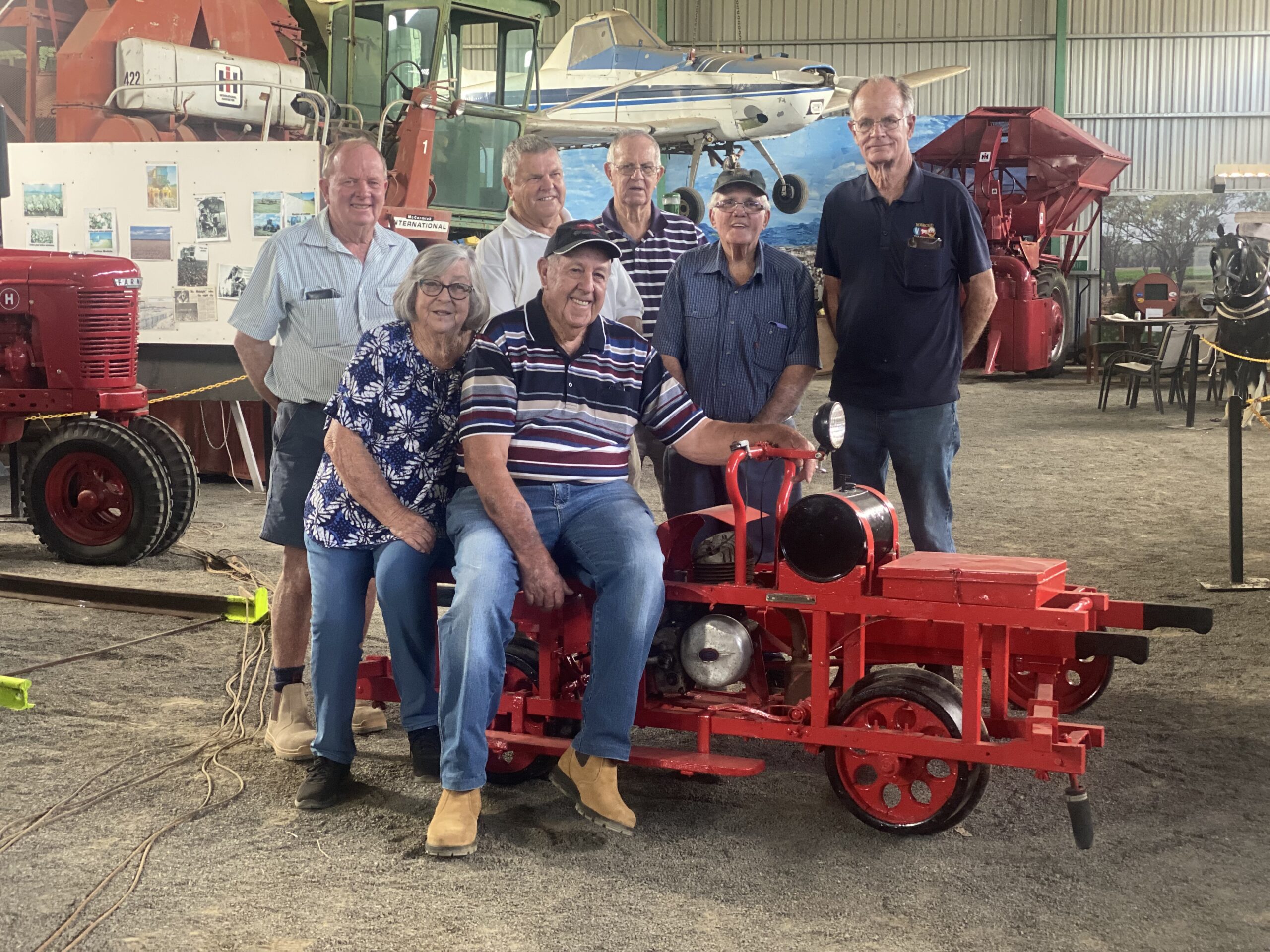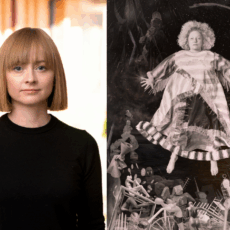When a restoration project is finally finished and unveiled in all its shiny new glory, it’s hard to believe such a masterpiece was once destined for the scrap heap.
But that’s exactly where Ian Bailey’s decrepit old Trafalgar railway tricycle was heading before it received a long-overdue makeover from Wee Waa Men’s Shed members.
“I had it in my shed for probably 30 years, in bits and pieces, and in the end my wife had enough of it taking up space.
She said, ‘get rid of it, put it in the tip’,” explained Mr Bailey, who lives in Narrabri with his wife Eletha.
Fortunately, there’s nothing like the threat of a rubbish tip run to kick a ‘one-day-soon’ repair job into gear.
“Bruce Gray and I are mates, he came over to have a look at it and I said, ‘I wonder if Wee Waa Men’s Shed would like to have a go at this?’, “ said Mr Bailey.
“The answer was ‘yes’.
“They came over one day: picked it up, put it in the trailer, gathered all the bits and pieces, and look at the result – they’ve done a beautiful job.
“It looks great, thanks to Bruce Gray, Robert Kahl and Men’s Shed members who diligently restored this trike, which once patrolled the tracks north and south of Wee Waa railway station – rain, hail, or shine.
“In days gone by, heavy maintenance and renewals such as re-sleepering, re-railing and ballast reconditioning were carried out by special extra gangs of fettlers, usually five men, who were under the control of a fettling ganger,” explained Mr Bailey.
Fettlers maintained the railway lines using tricycles, just like Mr Bailey’s, as they were an easy way to transport staff and equipment along the train tracks to undertake repairs.
The tricycles were also useful when travelling out to railway accidents and breakdowns.
“They carried two men, and the tools would be stored in the side,” said Mr Bailey.
“The fettling ganger was directly responsible for the condition of his length of track.
“He, or one of his men, was required to ride over the length by trike every day to observe the state of the track and look for defects.
“This was called ‘running the length’ or ‘running the road’.
“Before the introduction of motor transport, lengths were of necessity short.
“They were normally seven miles, on both main lines and branch lines,” said Mr Bailey.
The brilliantly restored tricycle is an important part of our district’s railway history; saved by the handy skills and devotion of Men’s Shed members, Mr Bailey’s freshly-painted motorised Trafalgar trike is now on display at the Wee Waa Namoi Echo Museum.
“The colour was called ‘signal red’ and just about every railway station had one,” said Mr Bailey.
“The motorised Trafalgar trike with 125cc Villiers motor was introduced in about 1920.
“Early units only had three wheels; this one has four.
“Made of all hardwood timber including the wheel spokes, the first Trafalgars weighed in at about 180 kilograms.”
As a railway enthusiast and lover and collector of all things trains, Mr Bailey said he was “so pleased” to see the restored trike on show at the museum for locals and visitors to learn more about and enjoy its past.
“There wasn’t much representation of railways here in the museum,” said Mr Bailey.
“It’ll be good for the kids to see, nowadays they drive a Toyota on the tracks with air-conditioning, radio – the whole thing.
“Kids come in here and they are gobsmacked by some of the things, they don’t believe what they see, and they ask what it was used for.
“I think most young kids love steam engines – the power of them and the noise.
“I grew up in an era where it was all steam trains and trains, we’d go to Moree for a swim in the baths on Sunday, and we’d just get on the old paper train and go down.
“The paper train used to deliver the papers from Sydney, and they’d get to Narrabri at about 10 o’clock and Cliff Ozanne who worked for the paper shop would get a big bundle of papers and undo them, and there’d be people lined up everywhere just to get the Sunday papers.”
Mr Bailey said he thought the restored tricycle was mostly used at Burren Junction, once a big railway town, and he shared a story about how a Burren trike was once tasked on an emergency mission to help a local pregnant woman get to hospital during floods.
“It would’ve happened back in the 1950s; a heavily pregnant woman from Old Burren area needed urgent transport to Wee Waa hospital,” said Mr Bailey.
“With heavy rain and flooded roads, an S.O.S was sent out to the Burren Junction fettler crew for some railway assistance.
“A Trafalgar quad trike was quickly dispatched from Burren Junction by a gallant young ganger, who was in such a hurry to rescue the hapless lady-in-waiting that he derailed the rig twice.
“After arrival, the lady was made ‘comfortable’ in the toolbox of the trike, and they set off for Burren Junction in the pouring rain.
“Upon arrival at Burren Junction, the waiting ambulance officer and ganger sprang into action as the lady went into labour.”
Mr Bailey understands all went well, with the baby arriving safely and the mother and baby making it to hospital for a happy and healthy ending to the action-packed story.
The Powerhouse Museum’s website states there were strict rules associated with using railway trikes, but employees were known to use them “as a convenient way to visit neighbours or attend dances further up the line.”
“Tricycles were located at all railway stations outside the metropolitan area, engine depots and in the brake vans of trains,” states the Powerhouse website.
“Those housed at a station were used within a certain length of track from the station.
“The use of tricycles was strictly regulated, and safety instructions issued to riders to make sure they were aware of the times of passing trains coming into their section while tricycles travelling through sections had to be warned of trains.
“When riders came to a curve in the line, a cutting or a tunnel where they could not get a good view of the track ahead, they were instructed to stop the tricycle and listen for the sound of any trains.
“Care had to be taken when going over facing or trailing points as these could derail the tricycle.
“According to the Railways’ 1945 Book of Rules and Regulations, ‘An employee must not use a tricycle unless he can read and write, and has in his possession a watch which shows the correct railway time, a copy of the last issue of the Working Timetable corrected to date and applying to the district in which the tricycle is being used’ and ‘when a tricycle is used on a double line, it must be taken in the opposite direction to the ordinary trains, and always facing trains on the same line’.
“Riders were advised not to run their tricycle backwards, nor to attempt high speed running unless they were used to their machines and to lean well towards the guide wheel when running around a curve.
“Despite all these rules forbidding tricycles being used at night unless absolutely necessary, they were known to be used by railway employees as a convenient way to visit neighbours or attend dances further up the line.”
The restored trike’s new home is not only a win for museum visitors and history buffs but also Mr Bailey’s wife Eletha, who now has more storage space at home.
“She’s absolutely relieved, we’ve cleaned the shed up, and it’s actually embarrassing just how clean it is.”
To order photos from this page click here










